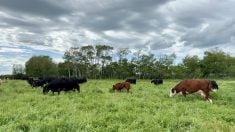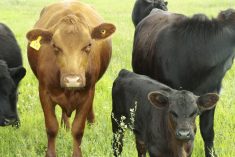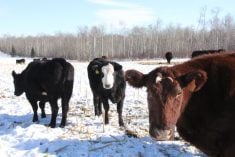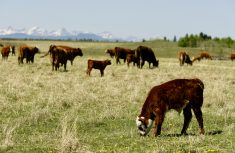This is a time of year when cattle feeders — particularly cow-calf operators and those backgrounding calves — attempt to purchase byproduct feeds to supplement homegrown forage supplies. Typically, one looks for low-cost ingredients that can serve as supplemental sources of energy and protein. In some cases, brokers are involved with the search while in other cases producers deal directly with grain terminals, pulse processing facilities, feed mills or specialty grain and oilseed processing plants. While there are a variety of available byproducts, producers often focus on purchasing raw screenings from these suppliers. Examples include dockage from cleaning wheat, canola, flax and mustard, as well as from pulse crops.
It has been my experience that in such cases, purchasing decisions are often based on price per tonne without regard for nutritional value, potential effect on animal health or relative economic value compared to more conventional sources of energy (i.e. barley or corn grain) or protein (i.e. canola meal or DDGS). My intent with this column is to highlight some of the issues one encounters when feeding raw screenings and to show the importance of looking at feeding value and not just the price per tonne when making purchasing decisions.
[RELATED] What to consider when choosing alternate cattle feed sources
Read Also

Canadian Beef Check-Off Agency reports on investments and activities
The check-off agency’s work behind the scenes is what ensures cattle check-off dollars are invested wisely, accounted for transparently and deliver measurable value back to producers and importers.
First let’s look at nutritional value. From my perspective, there are three components to nutritional value. The first is actual nutrient content. In this regard, screenings are one of the most variable feed products on the market. It is not uncommon to hear producers complain that one load came in at 11 to 13 tonnes and the next on the same truck weighed 25 to 30 tonnes. Screenings are comprised of chaff, dust, weed seeds and immature or broken seeds derived from the parent crop. The variability in weight and nutritional value will depend largely on the relative proportions of the components that make up the load. The more weed seeds and parent material, the heavier the load and, typically, the better the feeding value. However, the only sure way to know the nutrient content will be to have representative samples from several loads analyzed by an accredited feed testing laboratory.
The second aspect of nutritional value often overlooked by producers when purchasing raw or unprocessed screenings is nutrient availability (i.e. digestibility). Weed seeds, immature canola or flax seeds and shrunken wheat kernels are poorly utilized by the animal and often end up in the manure. Thus, even though a feed analysis indicates relatively good nutrient content, it is often necessary to apply a nutrient discount when formulating diets with these products. To give you an idea of what I mean, a study from the University of Saskatchewan (Pylot et al. 2000) found that the digestible energy content of raw canola screenings was only 81 per cent of that of processed canola screenings. Similarly, the crude protein digestibility coefficient of unprocessed canola screenings was 16 per cent lower than that of processed canola screenings. In that study, differences in nutrient digestibility resulted in cattle fed processed canola screenings consuming 30 per cent less feed dry matter than those fed raw screenings!
[RELATED] Interpreting a silage feed test
The final component of nutritional value is palatability — or in other words, will cattle readily consume them? While this is not generally an issue, excessive dust, obnoxious seeds (i.e. mustard seeds) and plant diseases such as ergot can all have a negative influence on intake. When I consider all three components making up nutritional value together, the screenings that I find consistently with the highest feeding value are those arising out of the pulse-processing sector.
The potential effect on animal health is important, particularly if one is considering feeding wheat and other cereal-derived screenings. Ergot contamination can lead to serious animal health issues including lameness, loss of extremities, abortions and death. If you are planning to feed screenings derived from the cereal grain sector, it is important to communicate with suppliers regarding the potential for ergot contamination. If you buy screenings locally, spring environmental conditions, particularly during flowering, can indicate the potential for ergot contamination. Cool, moist, spring conditions are favourable for ergot infection of cereals. This method, however, is not foolproof as screenings from a given terminal can arise from grain grown under a wide range of environmental conditions. Ergot contamination is not always visually identifiable; thus it is a good idea to inspect each load for contamination. I make it a practice to send representative samples of grain screenings for actual ergot alkaloid analysis to help guide their use in feeding programs.
The question of relative economic value is perhaps the hardest to answer. As discussed above, nutritional value is not based on nutrient content alone, but also digestibility and palatability considerations. For example, consider the situation where canola screenings at 18 per cent crude protein sell for $200 tonne and canola meal at 38 per cent crude protein sells for $450 tonne. Are the canola screenings really a better buy if only 60 per cent of the crude protein is digestible or if cattle must eat an extra 15 to 20 per cent of the ration dry matter to compensate for poor available energy content?
If you read this far, you might think I am against feeding screenings to cattle. Nothing can be further from the truth! I know several producers who incorporate them into their wintering feeding programs. Those who are successful, however, do not focus solely on price!

















